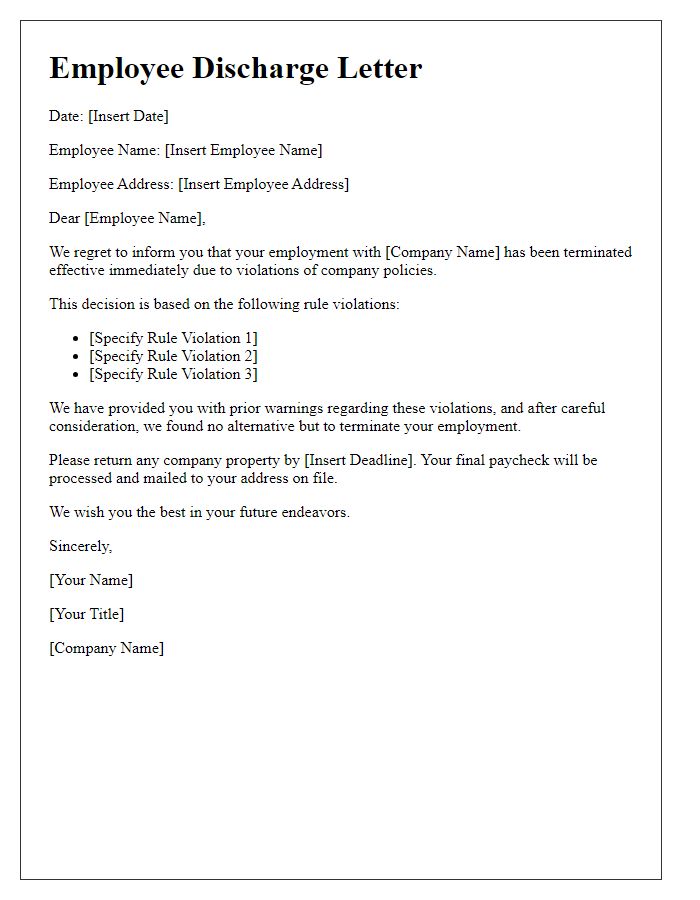When it comes to making tough decisions in the workplace, addressing employee misconduct is one of the most challenging yet necessary tasks for any manager or HR professional. Writing a termination letter not only formalizes the decision but also ensures that you communicate the reasons clearly and professionally. It's crucial to strike the right toneâone that is direct yet respectful, given the gravity of the situation. If you're looking for guidance on how to draft a termination letter due to misconduct, read on for a well-structured template that you can adapt to your specific needs.

Clear explanation of misconduct
Misconduct in the workplace can take various forms, including insubordination, theft, harassment, or violation of company policies. An employee, for example, may engage in repeated lateness, undermining team morale, and failure to follow operational protocols. This behavior not only disrupts workflow but may also result in employee dissatisfaction and a negative company culture. In some cases, misconduct can lead to legal ramifications for the organization, especially if it involves harassment or discrimination. Proper documentation of incidents and adherence to company policies regarding employee conduct are critical in addressing these issues effectively.
Reference to company policies
Termination due to misconduct can have significant implications for both the employee and the organization. A clear reference to company policies is essential for maintaining transparency and legal compliance. Many organizations outline specific behaviors categorized as misconduct, such as theft, harassment, and violation of safety protocols. For instance, a violation of the Employee Conduct Policy, which outlines expected professional behaviors and ethical standards, could lead to disciplinary action. Documenting incidents that led to termination is vital; detailed records should include dates, descriptions of the misconduct, and any previous warnings issued. Ensuring adherence to the company's Disciplinary Procedures is crucial, often detailing the steps taken prior to termination, such as verbal or written warnings. Adhering to relevant labor laws is also imperative to avoid potential legal repercussions.
Effective termination date
The termination of employment due to misconduct requires careful documentation and communication. Effective termination date must be clearly stated in the letter. Misconduct can range from theft, harassment, to poor performance or violation of company policies. When drafting such a letter, include the employee's name, position held within the company, and a brief account of the specific actions that led to this decision. Providing a list of relevant dates can enhance clarity, such as the date of the incident and when the employee was notified of the misconduct. It is essential to outline the appeals process, if applicable, to ensure transparency and fairness within the company's termination procedures.
Return of company property
The return of company property is a critical step in the termination process due to misconduct. This may include items such as laptops, security badges, uniforms, and any specialized equipment issued within the workplace, all of which should be accounted for. Company policy typically requires that all belongings be returned on or before the final day of employment, which can vary depending on the severity of the misconduct. Human resources departments often implement a checklist to ensure all items are collected, safeguarding sensitive information and proprietary assets. Locations for returns might include the main office, designated security areas, or through direct HR channels, ensuring a consistent and formal process during discharging the employee. Potential consequences of failing to return property may involve legal action or withholding of final paychecks, according to state labor laws and company protocols.
Contact for further information
The termination of employment due to misconduct can have significant implications for both the employee and the organization. Misconduct, defined by behaviors such as theft, harassment, or breaches of company policy, often necessitates a thorough investigation process to substantiate claims before final actions are taken. Organizations typically rely on documentation, such as warning letters and incident reports, to outline the misconduct in detail. Depending on the jurisdiction, legal implications surrounding wrongful termination may arise if proper procedures are not followed. Employees seeking further clarification on their termination circumstances may want to contact human resources or legal representatives for specific guidance and support regarding their rights in this situation.













Comments